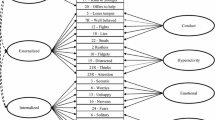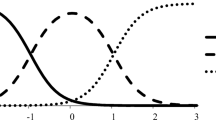Abstract
The parent-report Strengths and Difficulties Questionnaire (SDQ-P) is a widely used scale that assesses children’s and adolescents’ strengths and difficulties. The present study applied this scale to Italian adolescents and compared the current results with previous Chinese findings and the United Kingdom norm. Participants were 422 Italian parents and their adolescent children. Parents and adolescents answered the parent-report and the self-report SDQ, respectively. Results showed that the five-factor first-order model was better than other competing models. Cronbach’s alpha of emotional problems, conduct problems, hyperactivity, peer problems, prosocial behavior, and total difficulties was .63, .52, .69, .51, .59, and .77 respectively for mother-report measure, and .67, .48, .67, .46, .55, and .79 respectively for father-report measure. Parent–adolescent agreements ranged from low to medium, whereas mother–father agreements were large. Parents did not rate boys and girls as well as early-adolescence and mid-adolescence differently. Italian parents rated their adolescent children to have lower levels of hyperactivity, peer problems, total difficulties, and higher levels of prosocial behavior than Chinese parents; and Italian mothers rated their adolescent children to have lower levels of hyperactivity than United Kingdom parents. In conclusion, the current findings suggest both strengths and inadequacies of the SDQ-P for Italian adolescents.
Similar content being viewed by others
Notes
The Italian version of the SDQ and the SDQ-P had been translated and back-translated; and it can be obtained on http://www.sdqinfo.org/.
References
Goodman R (2001) Psychometric properties of the Strengths and Difficulties Questionnaire. J Am Acad Child Adolesc Psychiatry 40:1337–1345
Hawes DJ, Dadds MR (2004) Australian data and psychometric properties of the Strengths and Difficulties Questionnaire. Aust N Z J Psychiatry 38:644–651
Du Y, Kou J, Coghill D (2008) The validity, reliability and normative scores of the parent, teacher and self report versions of the Strengths and Difficulties Questionnaire in China. Child Adolesc Psychiatry Ment Health 2:1–15
Niclasen J, Teasdale TW, Andersen A-MN, Skovgaard AM, Elberling H, Obel C (2012) Psychometric properties of the Danish Strength and Difficulties Questionnaire: the SDQ assessed for more than 70,000 raters in four different cohorts. PLoS One 7:1–8
Woerner W, Becker A, Rothenberger A (2004) Normative data and scale properties of the German parent SDQ. Eur Child Adolesc Psychiatry 13:110–113
McCrory C, Layte R (2012) Testing competing models of the Strengths and Difficulties Questionnaire’s (SDQ’s) factor structure for the parent informant instrument. Personal Individ Differ 52:882–887
Muris P, Meesters C, van den Berg F (2003) The Strengths and Difficulties Questionnaire (SDQ)—further evidence for its reliability and validity in a community sample of Dutch children and adolescents. Eur Child Adolesc Psychiatry 12:1–8
Rodríguez-Hernández PJ, Betancort M, Ramírez-Santana GM, García R, Sanz-Álvarez EJ, De las Cuevas-Castresana C (2012) Psychometric properties of the parent and teacher versions of the Strength and Difficulties Questionnaire (SDQ) in a Spanish sample. Int J Clin Health Psychol 12:265–279
Bourdon KH, Goodman R, Rae DS, Simpson G, Koretz DS (2005) The Strengths and Difficulties Questionnaire: US normative data and psychometric properties. J Am Acad Child Adolesc Psychiatry 44:557–564
Moreno J, Silverman WK, Saavedra LM, Phares V (2008) Fathers’ ratings in the assessment of their child’s anxiety symptoms: a comparison to mothers’ ratings and their associations with paternal symptomatology. J Fam Psychol 22:915–919
Sanne B, Torsheim T, Heiervang E, Stormark KM (2009) The Strengths and Difficulties Questionnaire in the Bergen child study: a conceptually and methodically motivated structural analysis. Psychol Assess 21:352–364
van Roy B, Veenstra M, Clench-Aas J (2008) Construct validity of the five-factor Strengths and Difficulties Questionnaire (SDQ) in pre-, early, and late adolescence. J Child Psychol Psychiatry 49:1304–1312
Palmieri PA, Smith GC (2007) Examining the structural validity of the Strengths and Difficulties Questionnaire (SDQ) in a US sample of custodial grandmothers. Psychol Assess 19:189–198
Goodman A, Lamping DL, Ploubidis GB (2010) When to use broader internalising and externalising subscales instead of the hypothesised five subscales on the Strengths and Difficulties Questionnaire (SDQ): data from British parents, teachers and children. J Abnorm Child Psychol 38:1179–1191
Stone LL, Otten R, Engels RCME, Vermulst AA, Janssens JMAM (2010) Psychometric properties of the parent and teacher versions of the Strengths and Difficulties Questionnaire for 4- to 12-year-olds: a review. Clin Child Fam Psychol Rev 13:254–274
Davé S, Nazareth I, Senior R, Sherr L (2008) A comparison of father and mother report of child behaviour on the Strengths and Difficulties Questionnaire. Child Psychiatry Hum Dev 39:399–413
Li JB, Delvecchio E, Di Riso D, Nie YG, Lis A (2015) The parent-report version of the Spence Children’s Anxiety Scale (SCAS-P) in Chinese and Italian community adolescents: validation and cross-cultural comparison. Child Psychiatry Hum Dev (accepted)
Li JB, Delvecchio E, Miconi D, Salcuni S, Di Riso D (2014) Parental attachment among Chinese, Italian, and Costa Rican adolescents: a cross-cultural study. Personal Individ Differ 71:118–123
Sheikh S, Furnham A (2000) A cross-cultural study of mental health beliefs and attitudes towards seeking professional help. Soc Psychiatry Psychiatr Epidemiol 35:326–334
Hollingshead AA (1975) Four-factor index of social status. Unpublished manuscript
Goodman R, Meltzer H, Bailey V (1998) The Strengths and Difficulties Questionnaire: a pilot study on the validity of the self-report version. Eur Child Adolesc Psychiatry 7:125–130
American Psychological Association (2010) Ethical principles of psychologists and code of conduct. http://apa.org/ethics/code/index.aspx
Steiger JH (2007) Understanding the limitations of global fit assessment in structural equation modelling. Personal Individ Differ 42:893–898
Bentler PM (1990) Comparative fit indices in structural models. Psychol Bull 107:238–246
Cohen J (1992) A power primer. Psychol Bull 112:155–159
Steiger JH (1980) Tests for comparing elements of a correlation matrix. Psychol Bull 87:245–251
Cohen J (1988) Statistical power analysis for the behavioral sciences, 2nd edn. Lawrence Erlbaum, Mahwah
Benjamini Y, Hochberg Y (1995) Controlling the false discovery rate: a pratical and powerful approach to multiple testing. J R Stat Soc B 57:289–300
Glickman ME, Rao SR, Schultz MR (2014) False discovery rate control is a recommended alternative to Bonferroni-type adjustment in health studies. J Clin Epidemiol 67:850–857
Nunnally JC (1978) Psychometric theory, 2nd edn. McGraw-Hill, New York
Achenbach TM, Krukowski RA, Dumenci L, Ivanova MY (2005) Assessment of adult psychopathology: meta-analyses and implications of cross-informant correlations. Psychol Bull 131:361–382
Achenbach TM, McConaughy SH, Howell CT (1987) Child/adolescent behavioral and emotional problems: implications of cross-informant correlations for situational specificity. Psychol Bull 101:213–232
Rescorla LA, Achenbach TM, Ivanova MY, Harder VS, Otten L, Bilenberg N et al (2011) International comparisons of behavioral and emotional problems in preschool children: parents’ report from 24 societies. J Clin Adolesc Psychol 40:456–467
Delvecchio E, Mabilia D, Di Riso D, Miconi D, Li JB (2014) A comparison of anxiety symptoms in community-based Chinese and Italian adolescents. J Child Fam Stud 24:2418–2431
Goodman A, Heiervang E, Fleitlich-Bilyk B, Alyahri A, Patel V, Mullick MSI et al (2012) Cross-national differences in questionnaires do not necessarily reflect comparable differences in disorder prevalence. Soc Psychiatry Psychiatr Epidemiol 47:1321–1331
Author information
Authors and Affiliations
Corresponding author
Rights and permissions
About this article
Cite this article
Li, JB., Delvecchio, E., Di Riso, D. et al. Early Evidence of the Italian Parent-Report Strengths and Difficulties Questionnaire (SDQ-P). Child Psychiatry Hum Dev 48, 335–345 (2017). https://doi.org/10.1007/s10578-016-0646-3
Published:
Issue Date:
DOI: https://doi.org/10.1007/s10578-016-0646-3




